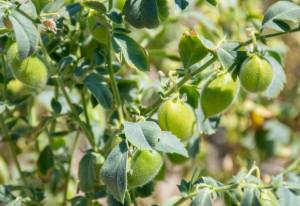Integrated Weed Management Practices for Organic Chickpea Production in the Northern Great Plains
Research Importance
There’s renewed interest in non-herbicide weed control practices to improve sustainability
in both conventional and organic cropping systems. Throughout the world, herbicides
are the most widely used method of weed control. However, they have been increasingly
linked to negative environmental impacts. Additionally, many weed species are developing
resistance, making herbicide-based weed management less effective and requiring the
integration of alternative weed management practices to control weeds.
In 2017, Montana, Washington, Idaho, and North Dakota produced 93% of the chickpea grown in the U.S., and chickpea grown in Montana alone accounted for 28.1% of U.S. production. Furthermore, between 2016 and 2017 chickpeas grown in Montana increased 59.5%, and accounted for 158,000 ha of agricultural production in 2018. While the exact number of chickpea hectares being produced organically has not yet been recorded, Montana has the second-largest certified organic acreage among U.S. states. And, with increasing demand in domestic consumption, a generally rising growth in volume exports, coupled with relatively high prices in the organic chickpea market ($1.32-1.54US/kg for Kabuli types, nearly 3x greater than conventionally produced), farmers will likely continue to increase organic chickpea acreage into the future.
Research Summary
The integration of three types of weed control practices was evaluated for organic chickpea (Cicer arietinum L.) production in 2016- 2019 at the Western Agricultural Research Center of Montana State University (MSU). In 2016 and 2017 the weed control practices included crop variety choice (Black Butte and CDC Orion), two seeding rates (standard seeding rate or 1x at 43 seeds m-2 and 50% increase over the standard rate or 1.5x), and two mechanical weed control practices (flame weeding and shallow tillage). In 2018 and 2019 the weed control practices were altered due to extremely low germination rates of the CDC Orion chickpeas in previous growing seasons. Therefore, crop variety choice was eliminated and all treatments were planted with the same cultivar type (Black Butte). Otherwise, treatments were similar to previous years and included the mechanical weed control methods, shallow tillage and flaming, as well as three different seeding rates (1x, 1.5x, and 2x (1x = standard seeding rate of 43 live seeds per m2, 1.5x = 50%, 2x=100% increased seeding rate).
Data collected in each growing season included stand density, weed biomass, and yields across all treatments.
Results and Conclusions
There are no known studies that have been conducted to determine optimal weed management tactics for organic chickpea cropping systems. Currently, organic chickpea producers must rely on information used by conventional chickpea farmers. However, many studies have shown that increasing plant densities in both conventional, as well as organic cropping systems, may increase a crop’s competitive ability and reduce the need for mechanical and/or chemical weed controls, while increasing yields.
Results from 2016-17 showed that Black Butte was associated with higher crop densities, greater grain yield, and lower weed biomass than CDC Orion. Increasing Black Butte seeding rates increased crop densities and its grain yield by 26%. Flaming increased chickpea grain yield in 2016. The combined effects of shallow tillage and increased seeding rates resulted in reduced weed biomass. Shallow tillage can be successfully integrated to improve yields and reduce weed pressure in organic chickpea. However, the efficacy of shallow tillage depends strongly on proper timing. Generally speaking, when planted at higher than standard densities, the Black Butte chickpea is better at competing with weeds and produces greater yields than CDC Orion. Increasing seeding rate resulted in reduced weed biomass in conjunction with improved grain yield.
Results from 2018-19, showed that by increasing chickpea seeding rates to 1.5x the recommended rate, farmers could potentially increase yields by 50%. To do so, farmers are purchasing an additional 50 kg of seed per hectare but should expect yields averaging 450 kg/hectare greater than those planted at the standard rate. With organic chickpea prices at $1.32/kg, this gain translates into approximately $594/hectare before subtracting the increased seed cost (~$65). Conversely, we found that more is not always better in the case of seeding rates. As a 2x increase of the standard seeding rate yielded little to no gain over the 1.5x seed rate.
As mentioned above, weed management in organic systems relies heavily on the timely implementation of several tactics. We see proof of this in the combined effects of increasing our seeding rates and planting the seeds earlier than conventional methods recommend. Our results showed up to a 60% increase in yields when the Black Butte chickpeas were planted at 1.5x the standard rate earlier in the spring. Furthermore, simply planting this variety earlier than the conventional recommendation has the potential to increase overall stand densities as well as yields. While these findings held for Black Butte desi-type chickpeas, further studies should be done on other chickpea varieties that show promise for use in organic systems.
Several studies have been conducted where increased stand densities failed to reduce weed biomass, the 2019 portion of this study further supports these findings. While we did observe a reduction in weed biomass concerning the use of physical weed control techniques in 2018, these results did not hold in 2019. The results we observed in 2018 may have been due to the overall increased density of weed biomass in that field compared to the 2019 field site. There were noticeably more weeds to impact in the 2018 field whereas weeds in 2019 were almost nonexistent at the time of mechanical weed treatment.

